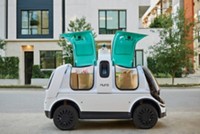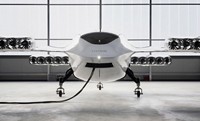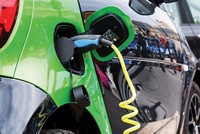Advertisement
Grab your lab coat. Let's get started
Welcome!
Welcome!
Create an account below to get 6 C&EN articles per month, receive newsletters and more - all free.
It seems this is your first time logging in online. Please enter the following information to continue.
As an ACS member you automatically get access to this site. All we need is few more details to create your reading experience.
Not you? Sign in with a different account.
Not you? Sign in with a different account.
ERROR 1
ERROR 1
ERROR 2
ERROR 2
ERROR 2
ERROR 2
ERROR 2
Password and Confirm password must match.
If you have an ACS member number, please enter it here so we can link this account to your membership. (optional)
ERROR 2
ACS values your privacy. By submitting your information, you are gaining access to C&EN and subscribing to our weekly newsletter. We use the information you provide to make your reading experience better, and we will never sell your data to third party members.
Business
Plastics makers plot the future of the car
Plastics in our vehicles will become increasingly specialized as cars lose their drivers and go electric
by Alexander H. Tullo
November 13, 2017
| A version of this story appeared in
Volume 95, Issue 45

This fall, hungry University of Michigan students are participating in an experiment. Ford Motor, in partnership with Domino’s Pizza, launched a self-driving delivery vehicle near the school’s campus in Ann Arbor.
A special Ford Fusion outfitted with radar and light detection and ranging equipment (lidar) will navigate the college town under the watchful eye of an engineer. Without a driver to bring the pizzas to their doors, customers will need to walk out to the car and unlock a compartment with a smartphone app. Ford Chief Executive Officer Patrick Doyle enthuses that his company is “excited to help lead research into how self-driving vehicles may play a role in the future of pizza delivery.”
But the effort has a bigger goal than just getting a hot pizza from point A to point B. It is one of many tests Ford is rolling out with the aim of having driverless vehicles in production by 2021. And Ford is laying down serious cash to do this. In addition to its internal efforts, the automaker is investing $1 billion in Argo AI, a Pittsburgh-based artificial intelligence and robots company that is developing a driverless system.
While companies work on autonomous vehicles, the global stock of cars is slowly electrifying. Some 750,000 plug-in hybrid and fully electric vehicles were sold worldwide last year, representing about 1% of the total car market, according to the International Energy Agency (IEA). U.S. consumers bought 160,000 hybrid and electric vehicles last year.
About 2 million hybrid and electric vehicles are on the road today, IEA reports. By 2020, that number will climb to between 9 million and 20 million, the agency expects, and from there it will more than triple by 2025.
“What the auto industry is facing is unprecedented in terms of the scale and the nature of change ahead of it,” says Richard Mayo, global business director of engineering plastics at the specialty products division of DowDuPont.
These changes are also influencing the business of supplying engineering plastics to the auto industry. Demand will increase for plastics used to make connectors and housings for the many electrical and electronic components required for both electric and autonomous vehicles. The use of plastics for parts unique to internal combustion engines, such as fuel lines and air intake manifolds, will gradually decline.
Plastics makers see opportunity in the auto industry’s evolution. The changes will place a premium on high-end materials that can withstand the extreme heat and electrical conditions in electric and autonomous vehicles. “The automotive industry needs partners that can help them navigate all of this change,” Mayo says. “This will mean exploiting existing materials but also, where necessary, developing new materials.”
Polymers have aided vehicle improvement for generations. Notably, they reduce vehicle weight when they replace heavier materials such as metal and glass, saving energy. An old rule of thumb in the auto industry says that for every 10% of vehicle weight reduction, fuel economy improves by about 5%.
Plastics impart other benefits as well. Cars are sleeker now that thermoplastic polyolefins and other polymers have replaced bumpers made of steel, and polycarbonate has replaced glass in headlamps. Car interiors are more ergonomic and quieter than they once were because of plastics.
Plastics also save carmakers money. For example, a nylon bracket that holds together components under the hood might have mounts and other features molded right into it. A similar part done in metal would be made of many pieces requiring expensive assembly steps.

For these reasons, the amount of plastics used in automobiles has increased over time. In 1960, the average car made in North America had only 8 kg of plastic and composite materials, according to the American Chemistry Council, a trade group. In 2016, the typical car was made with 151 kg of plastics and composites. This represents about 8% of the car’s weight and about 50% of the volume of materials in the car.
In the U.S., cars will need even more plastics to reduce weight if they are to meet fuel economy standards. By 2025, carmakers will need to get 54.5 miles per gallon (23.2 km/L) from their fleets on average to meet federal regulations. Today, according to the U.S. Environmental Protection Agency, the average new car gets only 24.8 miles per gallon (10.5 km/L).
Automakers will need to sell more hybrid and electric vehicles to hit these targets. At the same time, they continue to advance toward fuel economy goals through improvements in conventional internal combustion engines.
“The new engines are more powerful while fuel economy is getting better,” says Joel Kopinsky, director of the ITB Group, a consulting firm that specializes in helping suppliers to the auto industry with technological transitions. He cites, for example, a new in-line six-cylinder engine made by Mercedes-Benz. It has power comparable to that of an eight-cylinder motor and sips gas like a four-cylinder one.
Towards the plastic car

And Kopinsky points out that internal combustion engines will be a part of the mix for a long time to come. While industry forecasts say electric vehicles will make up anywhere from 10 to more than 20% of the new car market around the world in 10 years, most cars will still be powered by internal combustion engines.
“Talking about moving from internal combustion engines to electric vehicles is simplistic,” Kopinsky says. “There will be a spectrum of electric, plug-in hybrid, etc.”
Dalia Naamani-Goldman, market segment manager for transportation at BASF, agrees. Broad global adoption of regulations such as those in France, the U.K., and China calling for an end to vehicles that run on gasoline and diesel by the year 2040 are a ways off. She’s confident that internal combustion engines will be part of a “healthy mix” of power trains in the meantime. “We believe that those engines aren’t necessarily dying even into the midterm,” she says.
And plastics are still making solid contributions to conventional vehicles, Kopinsky says. As engines get smaller and more powerful, demand will increase for plastics that can withstand temperatures of more than 200 °C. He points to engine mounts and coolant control valves as recent examples of novel uses of plastics under the hood. “Resin suppliers have been innovative over the past five years,” he says.
But the consensus in the industry is that a full transition to electric vehicles will indeed happen eventually. And given the millions of hybrid and electric vehicles already on the road, it is a transition that has already begun.
In these vehicles, plastics will continue doing what they have always done: Make cars lighter. Importantly, a lighter electric vehicle has a longer range. So-called range anxiety, the fear drivers have that their batteries will go dead far from a charger, is a major obstacle to adoption of electric cars.
“The effect of vehicle weight is even more pronounced in electrified vehicles since we are pushing the limits of vehicle efficiency,” says Ted Miller, Ford’s senior manager of energy storage strategy and research.
Indeed, slimming down electric vehicles will be a challenge. Batteries are heavy, and electronics add weight. In an all-electric vehicle, some heavy parts, like the engine, do disappear. Plug-in hybrids pose an even tougher problem because they have all the components associated with both gasoline- and electric-powered cars.
“It is hard to know what the application mix will be,” DowDuPont’s Mayo says. “One thing I think is unavoidable in any scenario is that you’ll need to take weight out. That plays directly to the strength of plastics.”
Patrick Cazuc, global automotive marketing leader for the specialty products division of DowDuPont, thinks electrification of vehicles could create structural applications for plastics that weren’t possible before. For instance, car companies have long talked about a “skateboard” architecture in which the chassis is mounted on a flat assembly of the power train and wheels.
“What the electric vehicle allows is for car manufacturers to design their vehicles in a fundamentally different way. That opens up for considerable breakthroughs in terms of design,” Cazuc says.
For polymer makers, the switch to electric cars, and eventually to autonomous vehicles, also means a greater focus on plastics for electrical and electronic components.
“There are already a significant number of polymer components used in electrified vehicles,” Ford’s Miller says. These parts, he says, include insulation for the bus bars that connect battery cells with high-voltage components, as well as battery enclosures made with thermoplastic composites.
Tamim Sidiki, global marketing director for electronics at DSM, says such applications are second nature to engineering plastics companies that have long supplied materials for the consumer electronics and auto industries. “Now with all the changes coming up in electric cars and autonomous cars, we think that these two industries are fully converging,” he says.
One of the challenges for polymer makers will be supplying materials that can handle the high temperatures associated with the voltages used in electric vehicles.
“Ultimately, the goal for any of these electrified technologies is to increase power density,” explains Brian Baleno, global automotive business development manager at Solvay. “And when you’re increasing power density, you’re generally increasing voltage, which drives up temperature.”
Some of the resins needed to meet the challenge are familiar. For example, Baleno is seeing increased demand for the high-end resins Solvay makes—such as polyphthalamides, polyphenylene sulfide, and polyether ether ketone—in high-voltage, high-heat applications like traction motors and power modules.
Companies are also developing new materials. DSM has introduced ForTii Ace, a modified polyphthalamide with a glass transition temperature of 160 °C, about 40 degrees higher than other polyphthalamides and 80 degrees higher than nylon 6,6, a common polymer used in applications that confront heat.
Sidiki notes the material can withstand these temperatures without organic heat stabilizers, the addition of which could lead to corrosion of electronics. A typical application, he adds, might be in connectors for a circuit board that houses important central processing unit chips and is connected to sensors from around the vehicle.
High-voltage shielding requirements pose another challenge. Components such as the electric motor can reach voltages of 400 to 600 V, versus 12 or 48 V for vehicles today. The higher voltages can lead to electrical arcing and radio-frequency interference problems.
“A lot of interference with signals can happen in a vehicle, everything from your GPS to your automatic door opener to your radio to your rearview camera,” BASF’s Naamani-Goldman says.
She notes that automakers are generally at the 1.0 version of their electric vehicles and are now using metal because it is a simple solution to shielding problems. Given time, these applications will start migrating to plastic filled with conductive additives. “If you can create a plastic that mimics the performance, you can eliminate processing steps and additional weight in some cases as well,” she says.
For autonomous vehicles, the electronics will only be more complex. “Not only do you have the standard infrastructure that is on a vehicle, but it is more heightened,”Naamani-Goldman says. Carmakers will need plastics for all the new cameras, radar, lidar, and sensors on the vehicles.
Autonomous vehicles will also have an acute need for reliability and redundancy. “If a connector is failing and the sensor is based on that, the whole functionality is breaking down, and it could end up in a fatal crash,” Sidiki says.
Solvay’s Baleno sees a need for high-end plastics in sensors for autonomous vehicles. Some polymers, such as nylon, have a propensity to absorb moisture and expand. This could prove dangerous if used, for example, to house a lidar unit meant to scan the road. Polyphenylene sulfide, which has high dimensional stability, would be better, he argues.
“The sensors need to maintain really tight tolerances and dimensions because when you have technologies that are talking to each other, if anything absorbs moisture or moves, your autonomous vehicle technology goes away,” Baleno says.
Such considerations are far in the future. This early into the ascension of electric and autonomous vehicles, it is impossible to predict what the full effects on the polymer industry will be.
Advertisement
Some things polymer makers do know for sure. DowDuPont’s Cazuc recalls a cartoon of an auto repair shop offering Tesla drivers a free oil change. Applications such as oil pans and fuel tanks will disappear in time. But polymers will pick up gains in other areas. Their role will evolve, but they will be as crucial to cars as they are today.





Join the conversation
Contact the reporter
Submit a Letter to the Editor for publication
Engage with us on Twitter